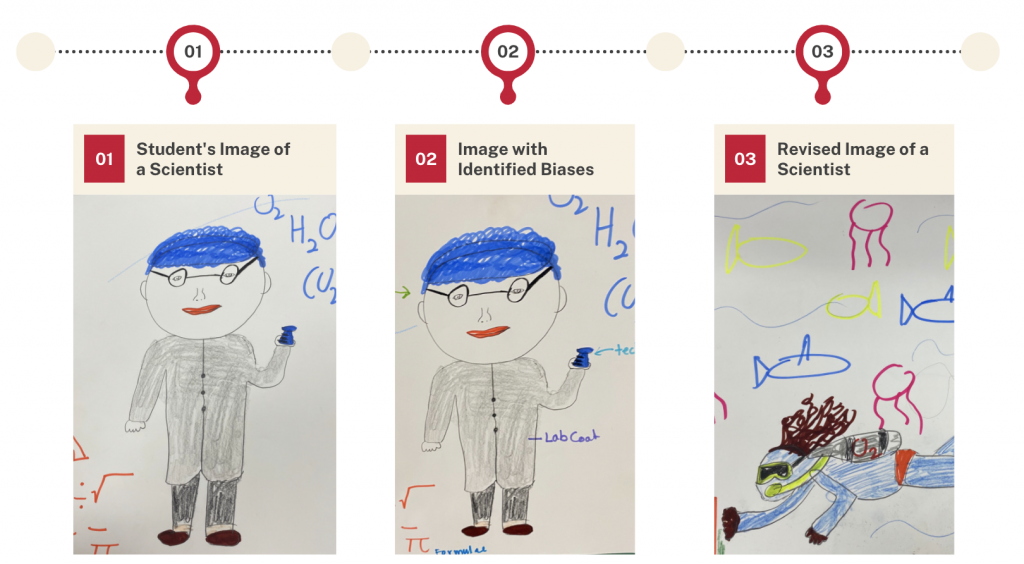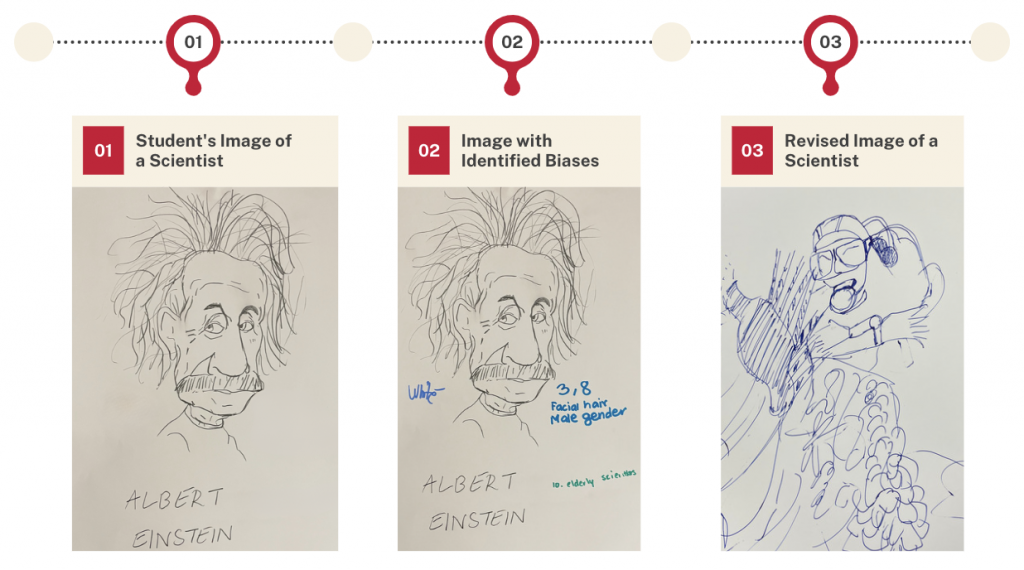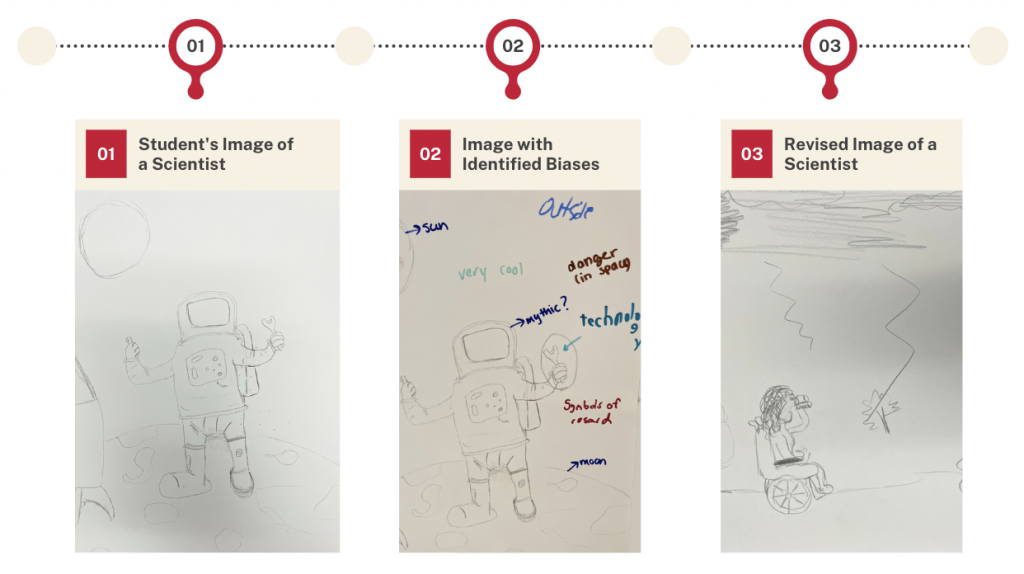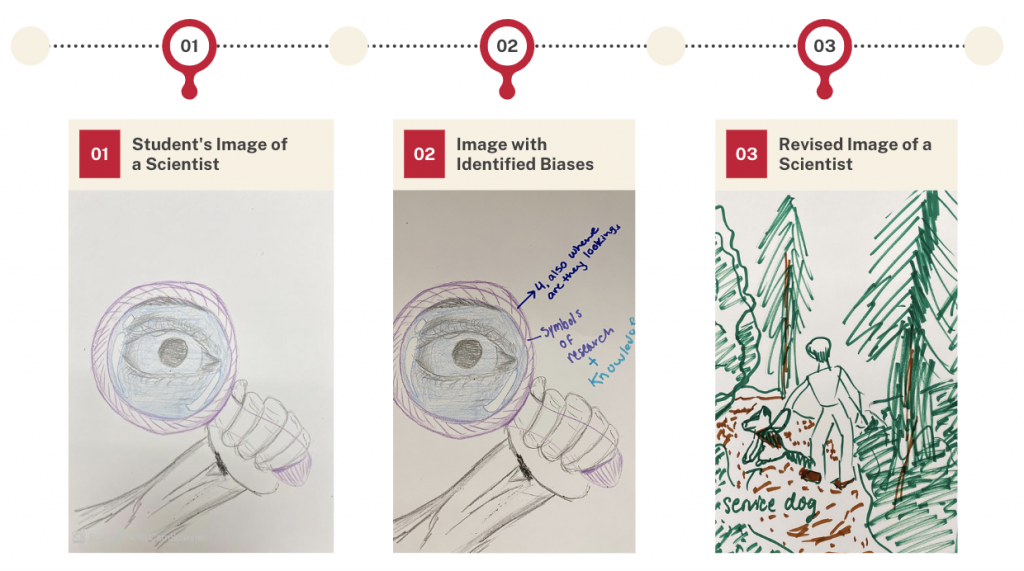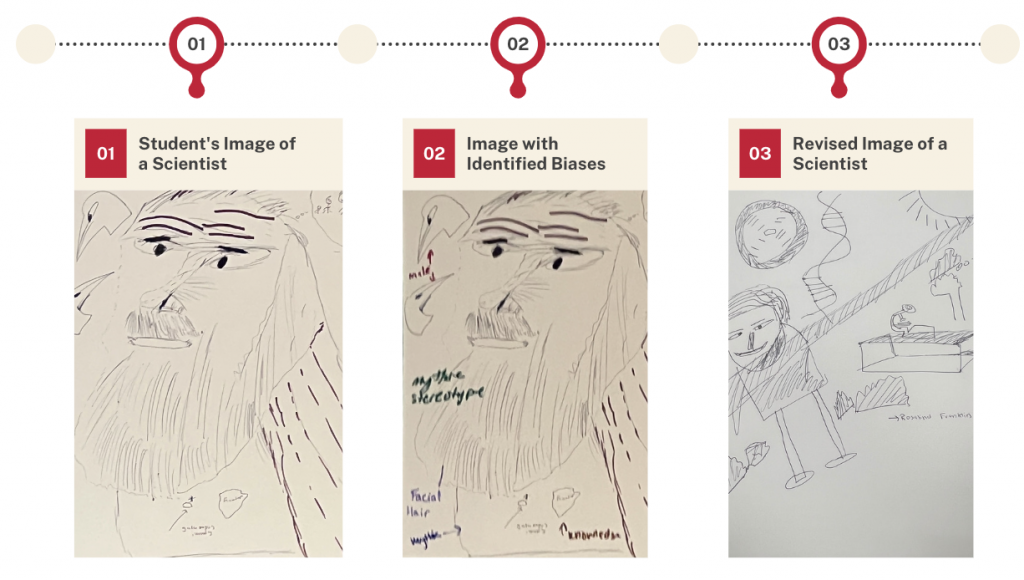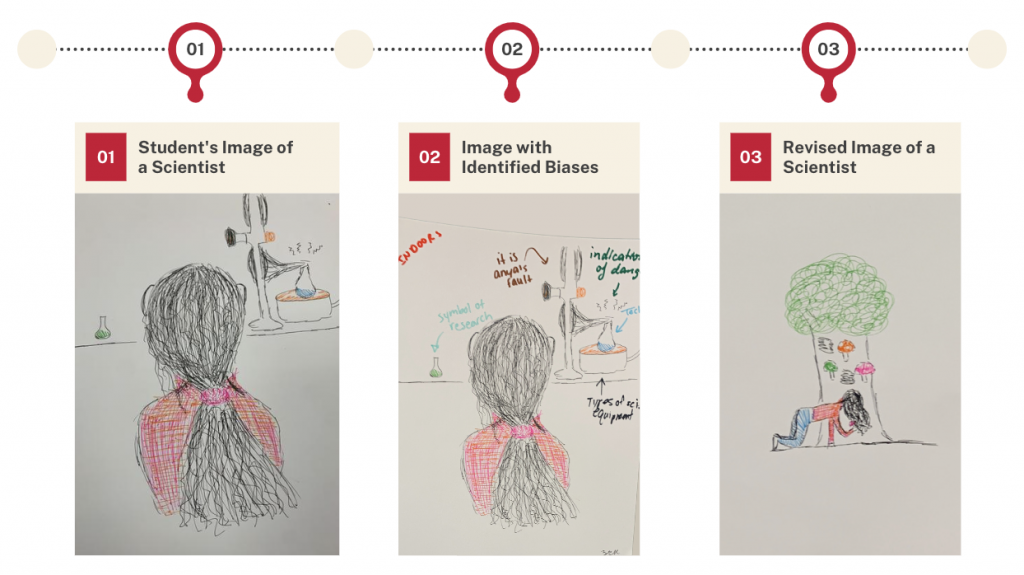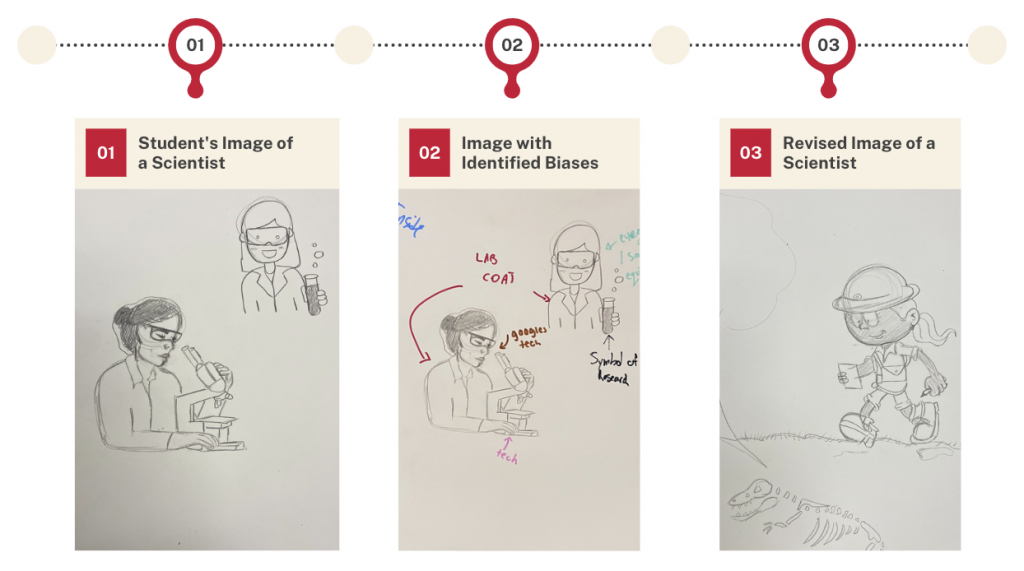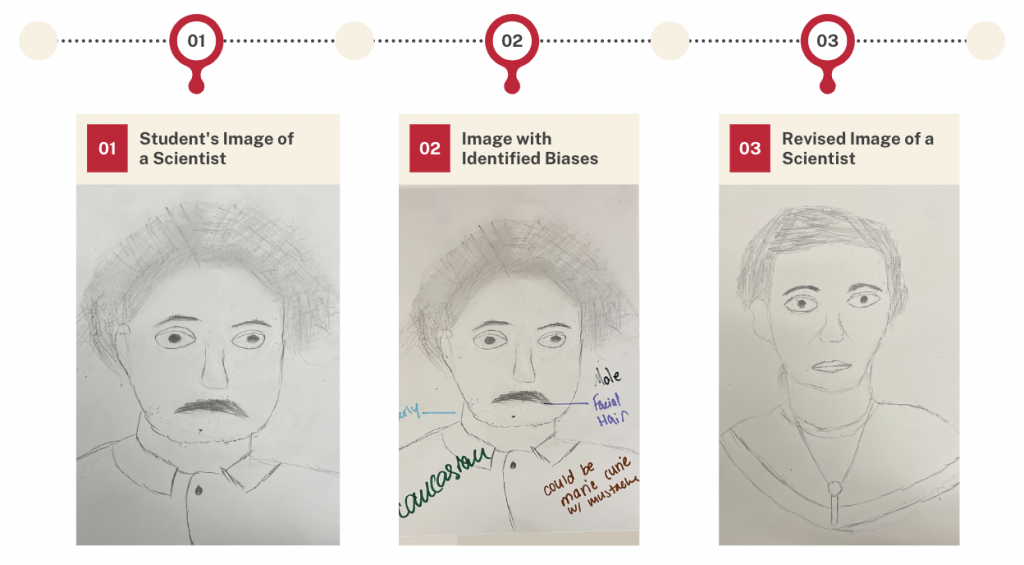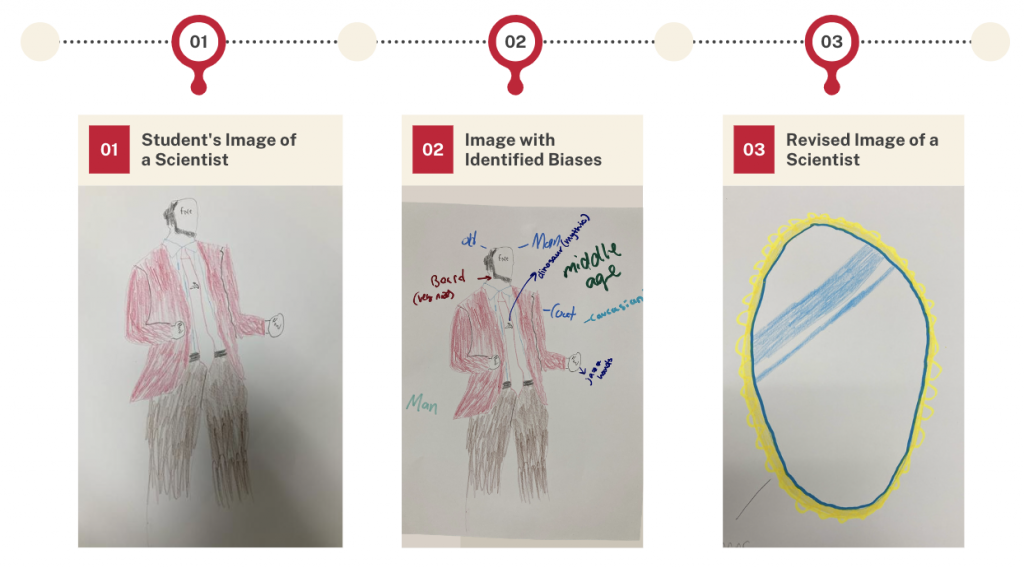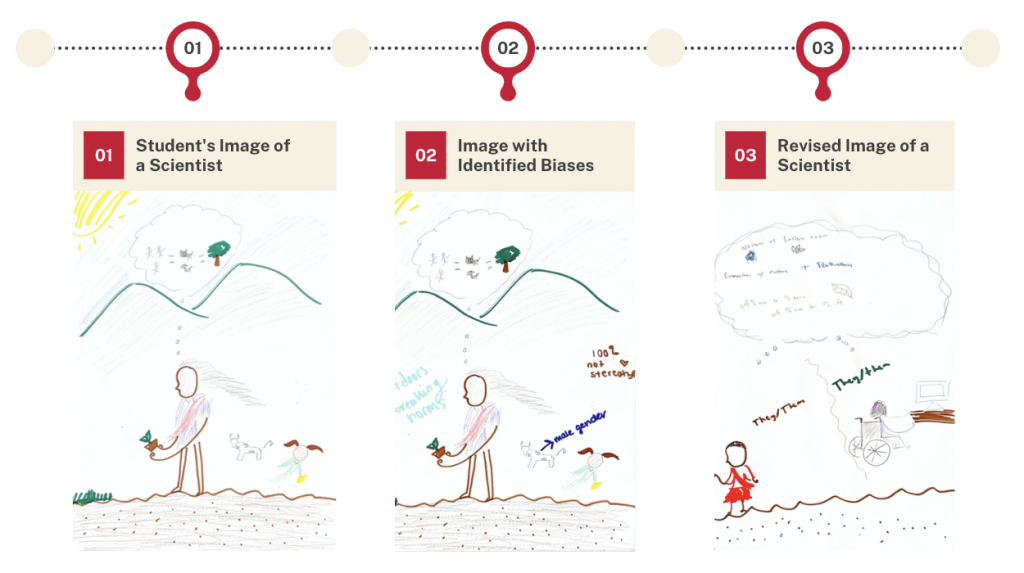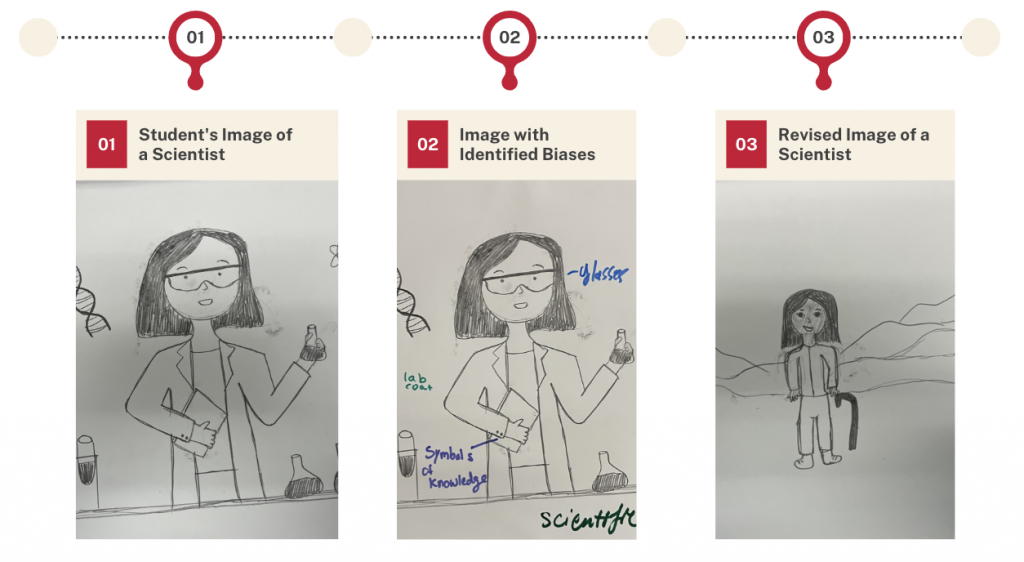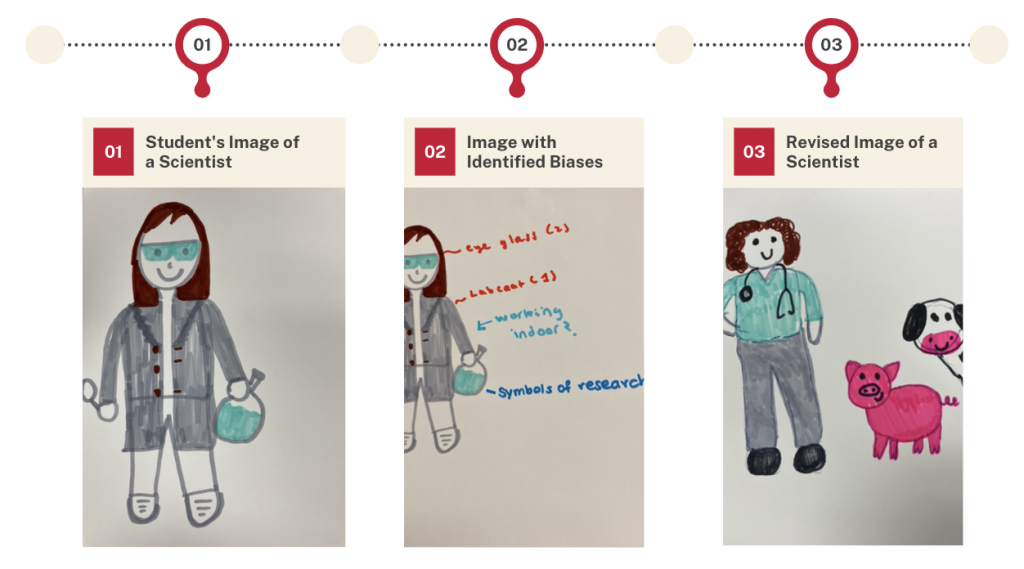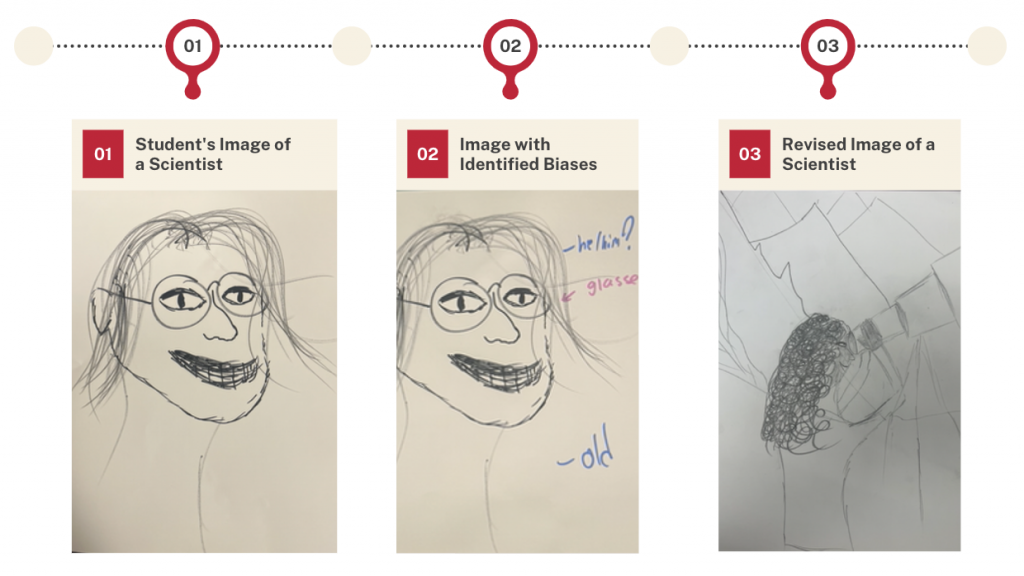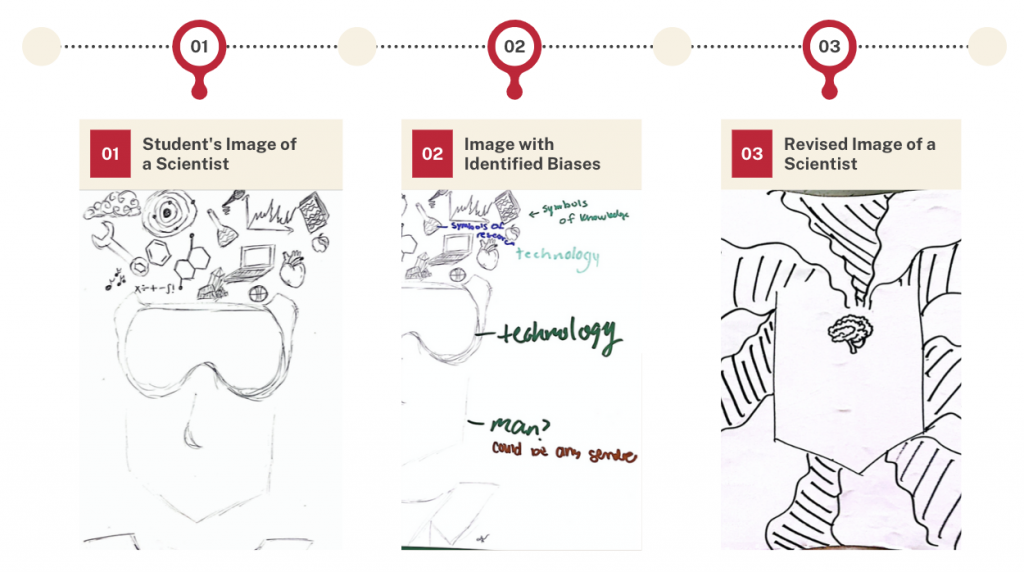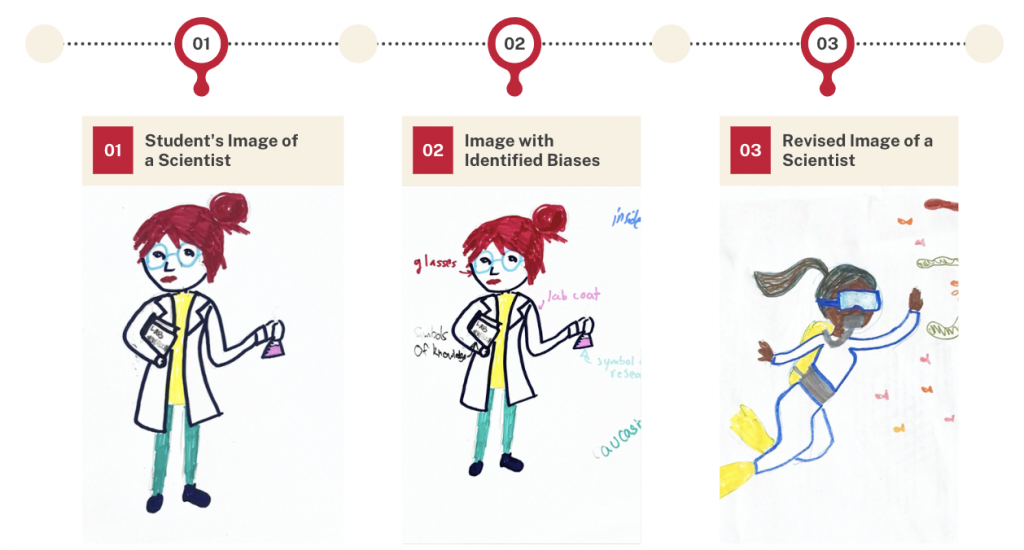Draw a Scientist
The “Draw a Scientist” test is a social experiment that has been studies by scientists for decades. This simple experiment ask students of all ages, genders, racial groups, and nationalities to create a picture of what they believe a scientist looks like. Research has shown that many stereotypical traits are usually depicted on these pictures indicating that these perceptions are persistent and pervasive among of the groups surveyed.1
Students in the class were asked to create a picture of what they thought a scientist should look like with little to no additional prompting. They were then given a checklist with many of the common stereotypical items, characteristics, and tropes that have been identified by researchers.2 Students examined all the pictures in the room and helped to identify all the stereotypes exhibited in the illustrations. The various unknown biases this revealed was then discussed as a group.
Finally, students were asked to create a second more inclusive and diverse picture of a scientist based on this discussion and write a short reflection statement. The results of this activity and the students’ reactions are shown below.
References
- Finson, K. D. (2002). Drawing a scientist: What we do and do not know after fifty years of drawings. School science and mathematics, 102(7), 335-345.
- Farland‐Smith, D. (2012). Development and field test of the modified draw‐a‐scientist test and the draw‐a‐scientist rubric. School Science and Mathematics, 112(2), 109-116.
______________________________________________________________________________________________________
I found it difficult to come up with an inclusive image of a scientist and when I did, I realized that it was not really inclusive and at the same time, truly ingrained with a traditional image of a scientist. I ended up ignoring the fact that a scientist is not only seen in a lab behind a microscope but rather can be in a rainforest hiking through the plants or snorkeling in the ocean examining ocean creatures. After examining all the traditional characteristics of what makes a scientist, it really made me think how in my whole educational career, I was very rarely exposed to anything beyond the image of a white, old man with a white coat and a microscope.
______________________________________________________________________________________________________
When first told to draw a scientist, an exact stereotype I would have is any person who looks like Albert Einstein, which is Caucasian male, mature with white hair, and probably is wearing a white blouse and holding chemical hazard things. After this activity and analyzing general bias that many of us previously had, I realized a lot of us made the mistake, not by intentions, but because of what we usually see on medias or previous educations. I really think the activity really pointed out what we need to fix and spread awareness regarding the “scientist” terms.
______________________________________________________________________________________________________
This activity really put into perspective how much we tend to stereotype different professions. Even when we are trying to be free of biases, sometimes we have subconscious biases that slip through the cracks. We have to be aware of these biases and actively combat them to make progress; science can be practiced by anyone, anywhere, and in a multitude, of ways.
______________________________________________________________________________________________________
When drawing my first picture, I was trying to represent the abstract idea of inspection, research, and study with the magnifying glass. What cannot be seen in the picture is that, in my mind’s eye, I intentionally gave the person no specific sex/gender; however, I was not thinking to be specifically inclusive of people of color.
In my second picture, after learning about the background of the Draw a Scientist study, I was intentionally trying to create a picture to be inclusive of a group of people that I see as underrepresented in the scientific and research community. So I drew a person and their seeing-eye dog walking through a forest, and I hoped that this imagery would be more inclusive of all people approaching science in their own unique way.
______________________________________________________________________________________________________
Initially, before doing the activity, I hadn’t realized how subconsciously my idea of a scientist had gradually slid into a stereotypical and inaccurate image. Now, it seems interesting to me how diverse our definition of a scientist can be. I intend to use this realization to disprove other misconceptions surrounding science that the public has to further a more accepting and inclusive image of the scientific community across the globe.
______________________________________________________________________________________________________
This activity made me think about how I and others fit into the idea of being scientists. I confronted my biases about how being a scientist is typically portrayed in an ableist way. I reassessed how I look at disability and science in the future because I want to be open and accommodating when collaborating and advocating in the sciences.
______________________________________________________________________________________________________
The activity made me realize that I do not know many scientists who are women. I can only name a few. It also showed me that professions can experience the effects of stereotypes, not just ethnicities, race, etc.
______________________________________________________________________________________________________
Going into this activity I assumed I was aware of and understood my biases surrounding science as a whole, however, the DAST Checklist showed me there were stereotypes my mind associated with scientists that did not depict the diversity and variability of the field of science. Seeing a written list depicting almost every image I associate with science forced me to take a look into myself a recognize that there were to my biases than I thought. Going forward, I will be more mindful of the fact that even seemingly small stereotypes play a role in painting science in a certain light that ignores the complexities of the subject.
______________________________________________________________________________________________________
I did not realize how widespread the image of scientists as older white men working in labs was. But culturally, that is what we have decided a scientist should simply look like. It’s an extremely narrow view on what type of person should be a scientist, and on what a scientists job even looks like.
______________________________________________________________________________________________________
When I first tried thinking of who a scientist is, I could not imagine any women scientists of color who looked like me. I then realized there were indigenous women such as Dr. Lydia Jennings and farmers such as Vandana Shiva who were still considered scientists and valued their connection to nature so I drew them since it is what I wanna be like. Then I realized we often assume genders and that scientists are always able-bodied so I wanted to challenge these by drawing nonbinary scientists who were disabled because they should be accepted and empowered in this community as well.
______________________________________________________________________________________________________
The Draw a Scientist activity was a great way to visualize my own perception of who a scientist is, including what they look like and what features define them, as this was not something I had considered before. I was surprised to see some of the aspects of our drawings that were seen as stereotypical, such as working indoors, wearing lab coats and glasses/goggles, and being surrounded by scientific equipment and other research tools, and was therefore confronted by some of the implicit biases that I have. I reassessed my outlook on the concept in my second drawing, where I illustrated a scientist who uses they/them pronouns, is a person of color (POC), has a disability, works outdoors, and doesn’t necessarily rely on any research equipment to conduct their work.
______________________________________________________________________________________________________
This activity made me think about how representation can impact one’s life. Without representation, people will not imagine themselves in specific fields, may not follow their passions, and the overall world may lose out on seeing that individual’s full potential. The activity also made me see all the small ways representation can be increased once we notice the problem and choose to steer away from stereotypes.
______________________________________________________________________________________________________
Shortly after I started drawing, I realized the point of the task was to serve as a social experiment to see what phenotypical characteristics people attributed to a generalized scientist. I then found it interesting to see how many white men were drawn before and after the rest of the class realized or were told about the experiment. I was really pleasantly surprised how many people did draw people of color or non male scientists initially, and even more pleased with how many made the effort to challenge their conceptualization of who a scientist should be.
______________________________________________________________________________________________________
This activity made me think not only about what I expect scientists to be like, but also what that expectation means for my own standards. As someone finishing my undergrad this semester, I still feel uncomfortable calling myself a scientist because of all the strange stereotypes I’ve subconsciously assumed all scientists have to fit. I hope overtime we can learn that being a scientist does not come from doing any specific thing or looking a certain way, but the way we approach problems.
______________________________________________________________________________________________________
This activity helped me broaden my definition of a scientist. My first drawing depicted a scientist with scientific tools and a lab coat, but science can be so much more than working in a lab. I also realized how stereotypes of scientists being white, male, and able-bodied can be harmful to anyone who doesn’t fit into this mold.
______________________________________________________________________________________________________
